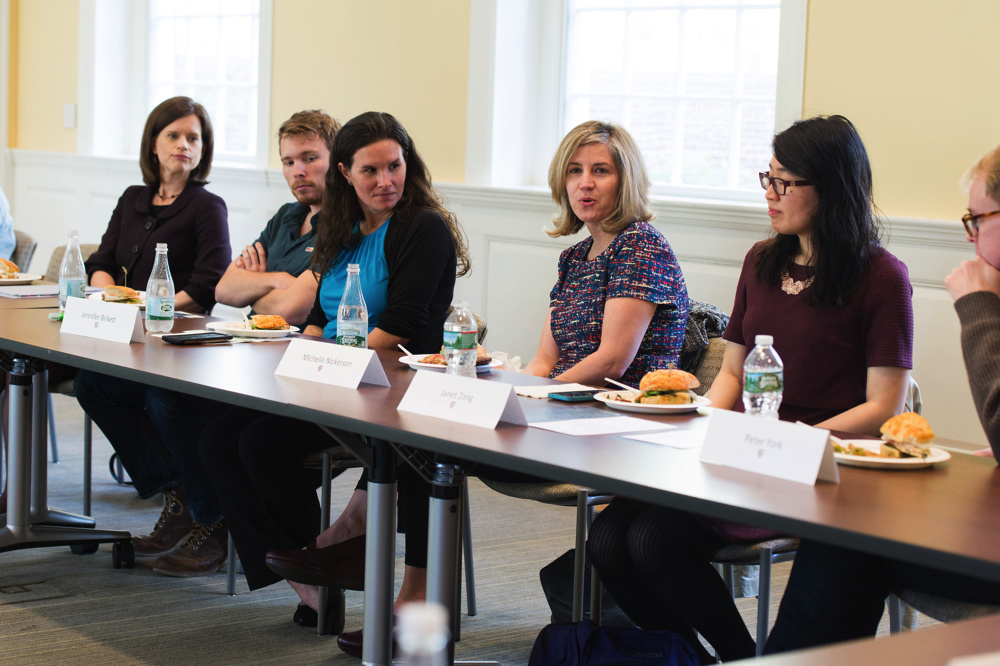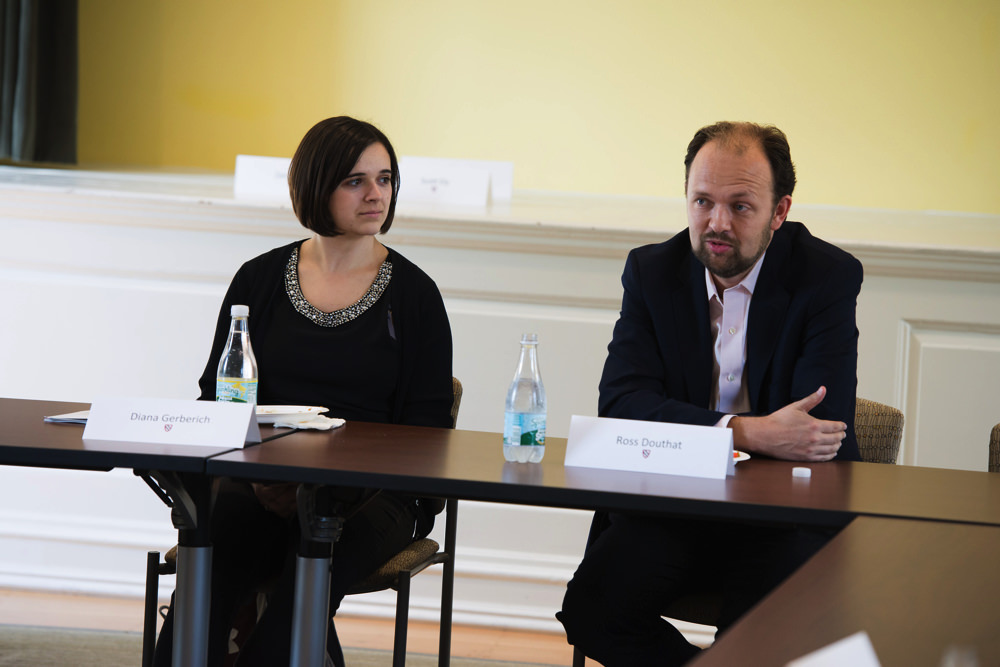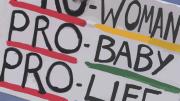“It’s been a long year,” Ross Douthat ’02 sighed gustily. He was lamenting the irony of being a Catholic conservative who lately found himself criticizing the Pope and the Republican nominee he’d expected to defend. “A long year for all of us, I think, in American politics. The world at large. But we’re here now.”
Here was at the Knafel Center at the Radcliffe Institute, where on an unseasonably warm and cordial afternoon this week, the self-described “token conservative” at The New York Times and “cultural go-between” presided over the panel “Righting the Record: Conservatism and the Archives.” As Jane Kamensky, professor of history and Pforzheimer Foundation Director of the Schlesinger Library, explained in her introductory remarks, a gap exists in the archives: “Politically conservative women and grassroots conservative organizations focused on the household have been doubly hidden by gender and ideology.” She cited the death of activist Phyllis Schlafly, A.M. ’45, as a signal reminder that “Even the longest-lived activists eventually pass into history. We’re at a generational turning point for the heated family-values contest of the post-World War II era. They’ll either make their way into institutions, or suffer the fate of most of the records of most of humanity over most of history, which is to be lost.”
“We won't make this a conversation about Donald Trump,” promised Douthat. But two days before the final presidential debate, and three weeks before Election Day, the conversation—shadowed by the candidate’s yet-undetermined legacy—felt more than merely academic. The event was an attempt to exemplify the kind of civil discussion that could take place among people with different ideologies; it was also described by participants as a trust-building exercise between the conservative guests and the liberal-leaning Harvard community. But at its core, the dialogue itself, over how to maintain a fuller history of the right, reflected a current political angst: who defines conservatism—the elites or the grassroots, the fringe or the center?
Panelist Donald Critchlow, a history professor at Arizona State University, described writing the political biography of Phyllis Schlafly. Before her death, the activist gave him complete access to her papers, as well as the personal and financial records of the “Stop ERA” campaign. “First of all, and I think this is important for getting collections, there was ego involved. She wanted her legacy to be known by future generations.” (The archives are now closed, despite Critchlow’s protests.) They also had personal rapport, Critchlow explained: though Schlafly didn’t oversee the writing of the book, she trusted that it wouldn’t be a hatchet job. Far more than their formal interviews, his chance encounters with Schlafly on his archive visits helped him see beyond her guarded public persona.

Jennifer A. Marshall of the Heritage Foundation (far left), and history professor Michelle Nickerson (middle right) at a lunch event with students
Photograph by Kevin Grady
Michelle Nickerson, an associate professor of history at Loyola University Chicago, also described a research process that went beyond the archives to the activists themselves. Looking in established archives for her dissertation about conservative women in Los Angeles during the Cold War, she found that, “For the most part, women were not jumping out of these papers. I found the papers by finding the real, live, breathing women." Nickerson sifted through political and governmental documents for names, then made cold-calls. She managed to record these conservatives’ oral histories and read the documents they’d stored in their suburban homes.
“It's necessary to emphasize that we need to collect the material of conservatives who we don't necessarily see every night on FOX News,” she said. “So what I'm saying is, it's not just elite conservatives, it's not just the people who you think of when we say ‘conservative,’ who we have to collect. That category doesn't just include women, it also includes black Republicans, Korean Christian conservatives, and others who don't come to mind when we think of Phyllis Schlafly."
The panel also included two activists. Jennifer Marshall, who oversees the Heritage Foundation’s Institute for Family, Community, and Opportunity, emphasized the need to distinguish between central and fringe aspects of a movement. “Take conservatism on its own terms. Investigate and present its stated principles, rational, and aims,” she urged. “Discern its internal coherence rather than project extrinsic theories on it. Identify authentic representatives and emblematic expressions of it."
“It's really hard to determine who are ‘the real conservatives.’”
Charmaine Yoest, the former head of Americans United for Life, made remarks that, from their very title—“Trust and the Other”—echoed rhetoric from leftist feminism, specifically the idea that political injustice is experienced physically: “I am an embodied woman. I live as a woman in this culture, and I’ve had many of the same experiences that my liberal feminist friends have had.” (Kamensky commented later, of both Marshall and Yoest: “I think they probably understand their political and ideological opponents way better than their political and ideological opponents understand them.”)
“Frankly, when you first called me, Jane, I didn’t trust you,” Yoest remembered. But, she continued, “Before we ended up talking about the panel, we talked about a whole range of personal things. It’s always fascinating to me that when you can sit down and talk as real people, real person to real person, there are so many areas of agreement about issues. It doesn’t mean that you come out on the other end agreeing about what should be done about issues, but it's a productive conversation when you can surface common experiences and common emotions and common challenges.”
“As we interact and try to understand each other's positions better,” Yoest concluded, “I think it’s important to ask ourselves, are we assuming bad faith on the other part?”
Opening the group discussion, Douthat began with the conflict between ideas promoted at the grassroots and those that matter to elites. “This tension is of particular relevance—I’m sorry to bring it back to crass politics—in the age of Donald Trump,” he said. “How hard is it to finesse that balance, where you’re simultaneously trying to take ideas as seriously as possible, and deal with the most serious articulations thereof, while also being alert for the deep tensions that open between populist currents and what the elite say conservatism or liberalism is?”
Critchlow answered that historians needed to separate ideology from politics: “Politics is about power, winning power, and in a democracy it’s about winning an election.” Academics, he contended, can focus too much on inconsistencies in ideology, even as politicians do not necessarily hold systematic worldviews or pursue long-term strategies.
Nickerson added that her own research also pointed to this contestation of who represents conservatism. She described the subjects of her research as people who read The National Review, but went unnoticed in its pages. “They were doing some things that elite political actors would refer to as ‘crackpot,’” she said, continuing: “They were spinning conspiracy theories. In fact, you might even call it reactionism, at the time. It was pretty populist. Yet they were very important to the emergence of the John Birch Society and the Goldwater movement. It's really hard to determine who are ‘the real conservatives.’”
“Even to recognize that those different strands exist is a step in the right direction,” offered Marshall.
“But you also come to these moments—and we’ve had one, in this election cycle—where some version of the grassroots, that is not supposed to be official conservatism, suddenly becomes politically immensely important,” continued Douthat, addressing his question directly to Yoest. “When you think about the year that religious conservatives have been through, with Trump, I’m just curious about what your reaction is and how you see that playing out—maybe specifically the different ways that people in your movement have tried to negotiate the rise of Donald Trump?”
Yoest answered that while some might focus on near-term tactics for the next election, she and her allies were taking a longer view. “Both movements and politicians who endure for any amount of time have to have a longer horizon,” she said, equably.
“I guess what I’m getting at, though, not to put you on the spot, but there is this sort of—there’s a very specific civil war over how you marry idealism to tactics, basically, with the specific question being, should pro-lifers, and religious conservatives more generally, support Trump?” Douthat pressed. “Do you think that this moment is a real crisis for the movement, or do you think it’s one of these political moments that will fade?”
Yoest replied that though she thought this election was significant—“The results matter,” she said emphatically. “Winning matters!”—she also believed that the political system was designed to be resilient: “I don’t think anybody can tell you what’s going to happen with these different factions that have materialized and revealed themselves, until we see what the results are.”

Ross Douthat ’02 at an event before the panel
Photograph by Kevin Grady
Reflecting on the event in a later interview, Kamensky described efforts to widen the political scope of the Schlesinger Library as just one facet of a multi-front diversity effort. But with regard to this particular gap, she explained, “Like many archives that have their root in a social movement, we’re tilted toward the allies of that movement.” A 1943 gift by the suffragist Maud Wood Park, in what was originally known as “The Woman’s Rights Collection,” established an area of strength that encouraged later gifts from Radcliffe’s network, further illuminating various feminist efforts. In general, progressive organizations have been more dedicated to keeping and maintaining good records, she said. “I think in the wake of the passage of suffrage, anti-suffragists didn’t come forward to libraries and say, ‘We have these fantastic collections documenting how we failed.’”
Those conservatives whose materials did end up at Radcliffe tended to fit a particular ideological profile. Kamensky characterized them as “Republicans in the model of Roosevelt to Rockefeller: global, internationally engaged, often supporting of women’s rights”—including family planning and abortion. For post-Goldwater conservatism, Radcliffe’s collections are thinner, partly because that history is more recent. Yet she added, “I think it’s partly on us that we haven’t, in a sustained and careful way, made the case for why an organization like Americans United for Life or Concerned Women of America would want to have their records beside the archive that has NARAL’s records.”
To that end, the event marked a serious beginning to a longer endeavor of building relationships, ultimately to broaden the historical record. Before the panel, the library staff held one-on-one meetings with the attending activists, and gave a tour of various holdings. These include pro-life ephemera: newsletters, films, and cassettes collected by the pro-choice activist Bill Baird. “We were able to show materials that were collected by quote unquote, ‘the other side,’” said Kamensky, “and it was fascinating to see Ms. Marshall and Dr. Yoest say, ‘That’s my friend’s email!’” She hoped that this demonstrated Radcliffe’s genuine interest, but also something more: “If you let your voice be heard through what your opponents have collected, you’re giving up a lot of the nuance in your story.”
The public discussion aimed to break down the barriers between scholars and activists, as well as between ideological opponents. “It was not a typical conversation,” said Kamensky. Then she added, “Such conversations would be more comfortable if we had them more often.”









